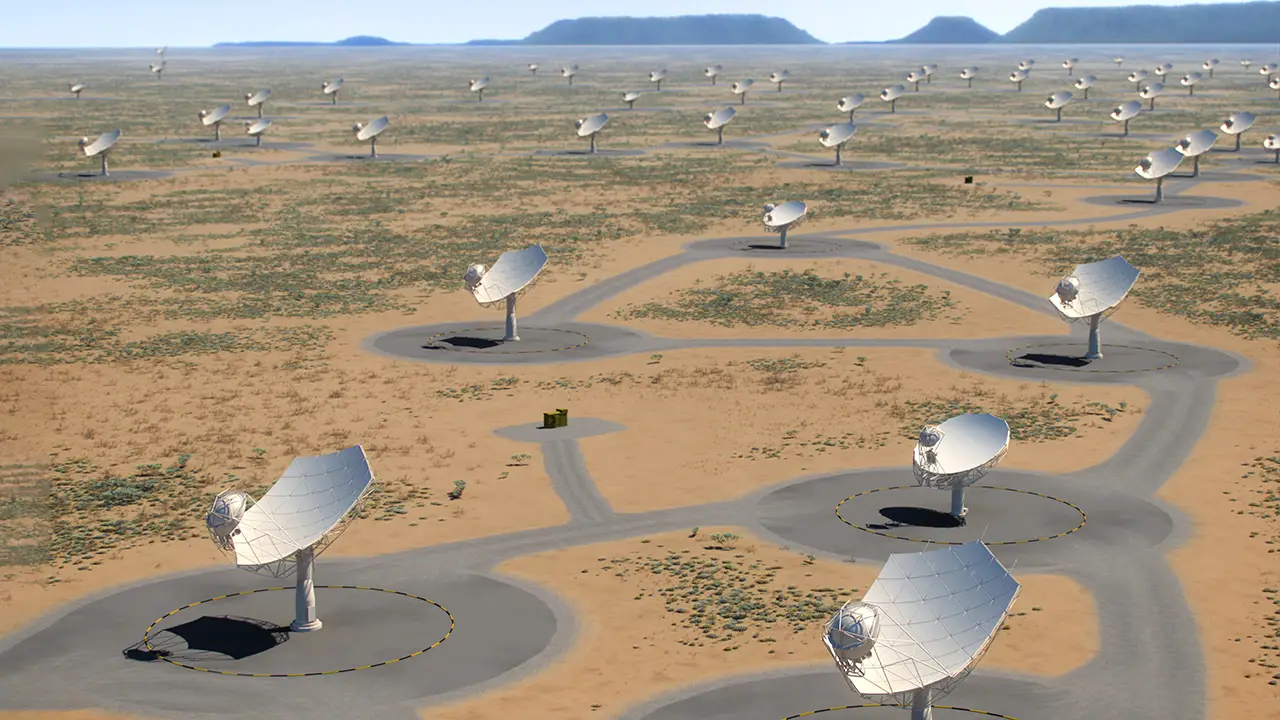The world’s biggest telescope, the Square Kilometre Array, is rapidly approaching completion. So far, 27 contracts worth around R1.6 billion have been awarded, with five more worth approximately R1.8 billion still up for bidding. The building of the Square Kilometre Array is projected to bring South Africa socioeconomic advantages such as job generation and skill development. Infrastructure construction on the Square Kilometer Array, the world’s biggest radio telescope co-hosted in South Africa’s Karoo, is planned to begin in 2022.
Also Read: Metrorail resumes Operations at Simon’s Town stations in South Africa
Since member governments approved the commencement of construction in June 2021, the intergovernmental project sponsored by South Africa and Australia has gained traction. The decision came after founding the Square Kilometre Array Observatory in 2021, which reflects member governments’ collective endeavour to build radio telescopes. This will be the world’s most sophisticated radio telescope network, gathering data across an area of around one square kilometre. According to the South African Radio Astronomy Observatory (SARAO), its size makes it “50 times more sensitive” and “10,000 times quicker” than existing radio telescopes. The project’s breadth necessitates scientific and engineering innovation.
The Square Kilometre Array (SKA) is expected to address some of the most fundamental mysteries about the cosmos, including how galaxies develop and whether or not there is life elsewhere. The SKA’s headquarters are in the United Kingdom, and it is in charge of overseeing the project’s development and operation in South Africa and Australia. Australia, China, Italy, the Netherlands, Portugal, South Africa, and the United Kingdom are among the original members.
Square Kilometre Array and Connection to the MeerKAT
Antenna dishes make up the radio telescopes located in the Karoo near Carnavon in the Northern Cape. Outstations will be situated across South Africa and in eight African partner nations, including Botswana, Ghana, Kenya, Madagascar, Mauritius, Mozambique, Namibia, and Zambia. According to SARAO, the second half of the telescope will be erected in Western Australia. SKA Phase 1 will include South Africa’s MeerKAT radio telescope, which has 64 dishes and is already located outside Carnavon. According to Business Insider, phase 1 of the project would add 130 additional dishes to the MeerKAT and 130 000 antennas throughout Australia. According to the SARAO, there will be a total of 197 dishes.
The procurement process for the SKA telescopes has already begun, with seven founding nations receiving 27 contracts worth a total of €90 million (about R1.6 billion). The majority of the contracts are for professional services and software development. According to the SKA organization’s website, five infrastructure projects totalling over €100 million (about R1.8 billion) are now available for bidding. These contracts cover lodging, road access, radio and fibre optic communications, and electricity, all of which must be in place before the building can begin on the sites.
Approximately 85% of the project’s 60 Tier 1 contracts are projected to be granted by the end of the year, with more than €500 million (almost R8.8 billion) in construction money committed. The project is anticipated to cost €2 billion (about R35 billion) in total, including construction and the first ten years of operation. According to the SKA Organization’s website, construction will last until 2028. The telescopes will last at least 50 years in terms of science.
What we reported earlier
November 2021 Progress on the MeerKAT Radio Telescope Extension Project
Concor, a black-owned construction company in South Africa, has updated its progress in laying the foundations and infrastructure for the MeerKAT telescope expansion project, which it is working on alongside OptiPower. MeerKAT is South Africa’s world-leading radio telescope array (and a forerunner to the international Square Kilometre Array radio telescope program). The expansion project includes the installation of 20 additional dish antennas. The MeerKAT telescope site is located in the Northern Cape province’s Karoo area, around 90 kilometers from Carnarvon. In September, the construction company began work on the property.
Also Read: Bosch Rexroth South Africa to install solar panels at its facility
MeerKAT Telescope’s Advanced Design
The MeerKAT telescope project also includes the building of roads and other infrastructure in addition to the dish foundations. The company’s first piles were drilled, and concrete poured in October when the piling rig arrived on site. Because of the soft soil and sandy conditions, the 20 foundations will be built on piles with a concrete cover; each foundation will have eight 750 mm diameter piles that will be between seven and eleven meters deep. The MeerKAT telescope is a highly accurate device. As a result, the dishes, including their foundations, must be precisely positioned.
Structures known as ‘bolt cages,’ to which the dish antenna pedestals are attached, must be sited with millimeter-level precision. (Each bolt cage is galvanized, has a height of 1.7 m, and is built to specification locally.) According to Concor contracts manager Stephan Venter, in addition to precision, the foundations must guarantee that the antennas can withstand the force of winds, which is especially important given the dish’s large surface area. All of this must be accomplished with the least amount of radio frequency interference possible (RFI). This is because RFI would not only cause the present MeerKAT array to malfunction, but it might also cause damage to its technology, which is meant to detect extremely faint radio signals from deep within the universe.
RFI is produced by mobile phones, car electronics, and a variety of other equipment and instruments. Venter went on to say that the business has tested and updated all of its on-site equipment to meet the RFI requirements. Excavators, trucks, graders, compactors, telehandlers, water bowsers, TLBs [tractor-loader-backhoes], and the company’s concrete batching vehicle are among the equipment they use.

